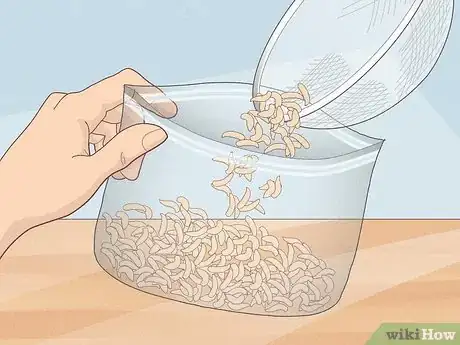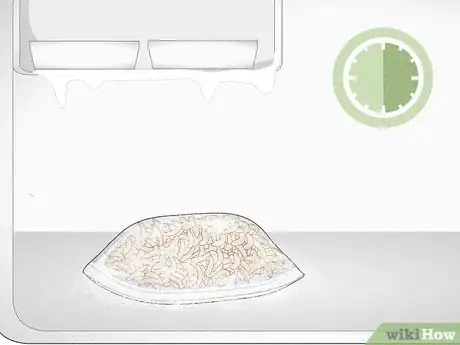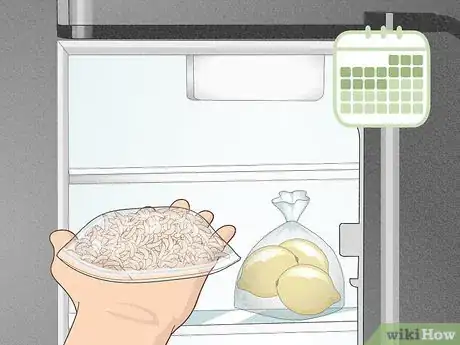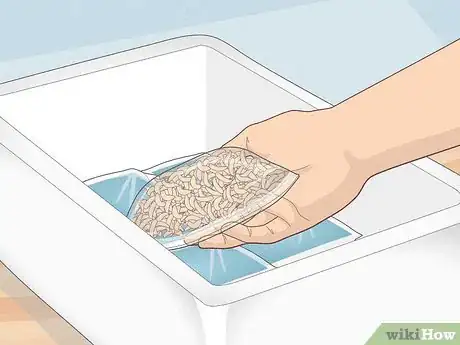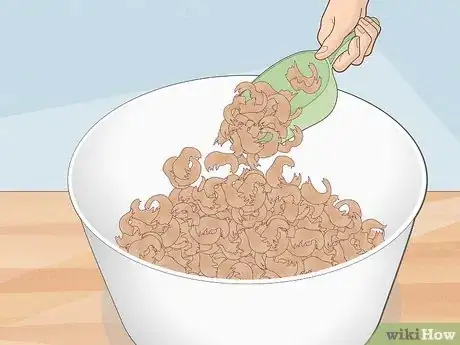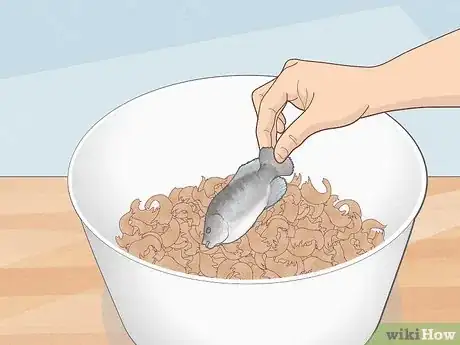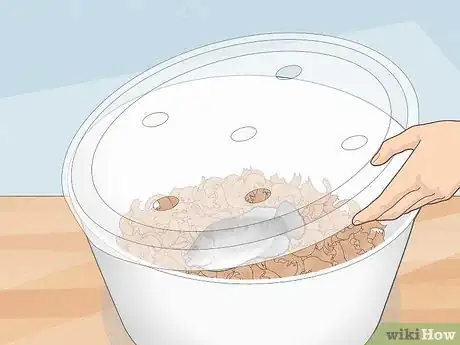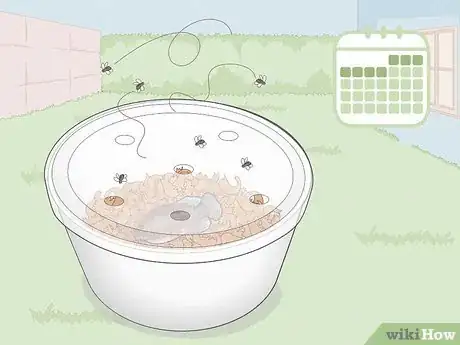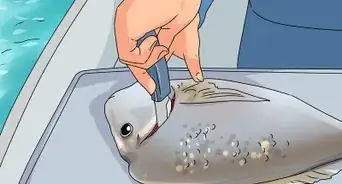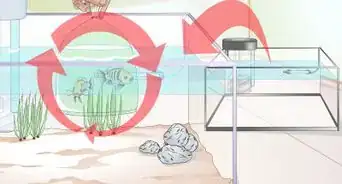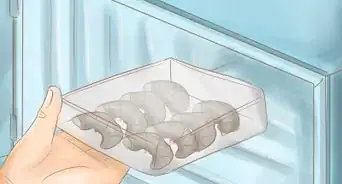This article was co-authored by wikiHow staff writer, Jessica Gibson. Jessica Gibson is a Writer and Editor who's been with wikiHow since 2014. After completing a year of art studies at the Emily Carr University in Vancouver, she graduated from Columbia College with a BA in History. Jessica also completed an MA in History from The University of Oregon in 2013.
There are 11 references cited in this article, which can be found at the bottom of the page.
This article has been viewed 19,156 times.
Learn more...
Although they're not pretty, juicy maggots make some of the best bait around! Instead of popping into the bait and tackle shop right before you go fishing, learn how to store live maggots at home. If you chill them properly, you can keep in them in a cold fridge for up to 2 weeks. Don't feel like buying maggots? With a little raw meat and time, you can cultivate your own and skip the trip to the shop.
Steps
Storage
-
1Shake live maggots in a fine-mesh strainer to clean them. If you're buying maggots from a bait and tackle shop, they'll probably be covered with sawdust or fine cornmeal. To clean the maggots before you store them, dump them into a fine-mesh strainer over a bowl and shake the strainer so the sawdust or cornmeal falls into the bowl.[1]
- You can throw out the sawdust or cornmeal.
- Try to buy the maggots as close to when you go fishing as possible since you can only store them for up to 2 weeks.
-
2Put the maggots into a sealable plastic bag. Get out a small plastic bag and pour the cleaned maggots into it. Press out as much air as you can before you seal the bag shut. Double-check the seal so you know the maggots won't get out![2]
- It's fine to use a small airtight storage container if you don't have a sealable plastic bag.
Advertisement -
3Freeze the maggots for 30 minutes to slow their metabolisms. The most important part of keeping maggots alive is preventing them from turning into casters, the stage before they turn into flies, which means you need to slow their metabolisms. Toss the bag in the freezer and chill the maggots for about 30 minutes so they stop moving around.[3]
- Don't store the maggots in the freezer for more than 30 minutes or they could turn brown and mushy when you defrost them.
-
4Store the chilled maggots in a cold fridge for up to 2 weeks. Turn your fridge temperature between 32 and 33 °F (0 and 1 °C) or as low as it will go. Then, put the bag of cold maggots into the coldest spot in your fridge—this is usually near the back of the fridge, away from the door. Then, plan on using the live maggots within a few weeks.[4]
- If you have a fridge dedicated to your bait, store the maggots in there so you don't have maggots in your regular kitchen refrigerator.
- There's no need to feed the maggots or care for them while they're in the fridge since their metabolisms are slowed.
-
5Place the maggots in a cold space or cooler if you don't have a fridge. If you don't have access to a fridge, don't worry! To store the maggots for a few hours or up to a few days, you can put maggots onto a cold, concrete floor like in your basement or garage. This works best during colder months. You can also stick the bag into a bait box or cooler and put a few ice packs in with them. This way, the maggots will stay cold until you can take them fishing.[5]
- This keeps the maggots alive for a few days if you swap out ice packs once or twice a day. Keep in mind that if they get too warm, they'll turn into casters and then flies!
-
6Take the maggots out of the fridge 15 minutes before you use them. The maggots start to wiggle around pretty quickly once you take them out of the freezer. Put your chilled bag of maggots into your tackle box and let them warm up on your way to go fishing. Then, push the flat end of the maggot onto your hook and you're ready to fish![6]
- You can put several maggots onto the end of your hook so you're more likely to attract fish.
Cultivation
-
1Put 2 inches (5.1 cm) of wood shavings into a 5 US gal (19 L) bucket. If you don't have a bucket that large, don't worry—you can use the largest, sturdy bucket you have as long as it's got a lid. Pour 2 inches (5.1 cm) of wood shavings or sawdust into the bucket to give the maggots something to burrow down into. It also absorbs moisture from the rotting meat.[7]
- You may want to label the outside of the bucket so no one gets a nasty surprise if they open it up!
- Some people have good luck with oats or bran instead of wood shavings, so feel free to give those a try.
-
2Place a palm-sized piece of raw fish or meat into the shavings. You can use a big chunk of raw fish from a past fishing trip or raw meat like chicken breast that you have in the fridge. Lay the raw meat into the bucket so it's right on the wood shavings.[8]
- As the meat rots, the smell attracts flies which lay eggs in the meat. These eggs become your maggots.
-
3Set a lid with holes on the bucket. Drill a few holes into the bucket's lid so flies can get in. If you don't have a drill or don't want to make holes in the lid, lay a few thin pieces of wood on top of the bucket and set the lid on top. Then, place a brick on the lid so it doesn't blow off.[9]
- If you have a problem with racoons or rats, go for the drilled holes since pests won't be able to get into the bucket as easily.
-
4Leave the bucket outside for at least 1 week or until you see maggots. If you're cultivating maggots in warm weather, the process won't take long—about 1 week. To cultivate maggots in cold weather, it can take up to 2 weeks. This is because the flies need to find the meat, land on it, and lay eggs before the maggots develop.[10]
- If you want to check on the process, look for small, white eggs on the meat. Once you see these larvae, it takes about 4 or 5 days for the maggots to be ready.
-
5Let the maggots crawl out of the wood shavings and store them. Set a fishing sieve over a bowl and pour the maggots with wood shavings into it. The maggots will wriggle through the holes and drop down into the bowl while the wood shavings will stay in the sieve. Then, transfer your maggots to a plastic storage container.[11]
- At this point, you can use the maggots for fishing, or chill them for up to 2 weeks.
Warnings
- Always wash your hands thoroughly with hot, soapy water after you handle raw meat or fish to prevent the spread of germs.⧼thumbs_response⧽
Things You'll Need
Storage
- Live maggots
- Fine mesh strainer
- Bowl
- Plastic storage bags
- Freezer
- Fridge
Cultivation
- Wood shavings or sawdust
- 5 US gal (19 L) bucket
- Raw meat or fish
- Wooden slat and a brick
- Fishing sieve
- Bowl
- Plastic storage bags
- Freezer
- Fridge
References
- ↑ https://youtu.be/Yii19N6mk9E?t=47
- ↑ https://youtu.be/Yii19N6mk9E?t=103
- ↑ https://youtu.be/Yii19N6mk9E?t=154
- ↑ https://www.outdoorhub.com/how-to/2018/02/23/keep-live-bait-kicking-throughout-winter/
- ↑ https://bestofangling.com/carp-fishing-with-maggots/0
- ↑ https://youtu.be/AIlk4l8nTt0?t=48
- ↑ https://youtu.be/JmrN6eHIS8k?t=152
- ↑ https://youtu.be/JmrN6eHIS8k?t=277
- ↑ https://coarsefishingtips.com/how-to-make-maggots/

